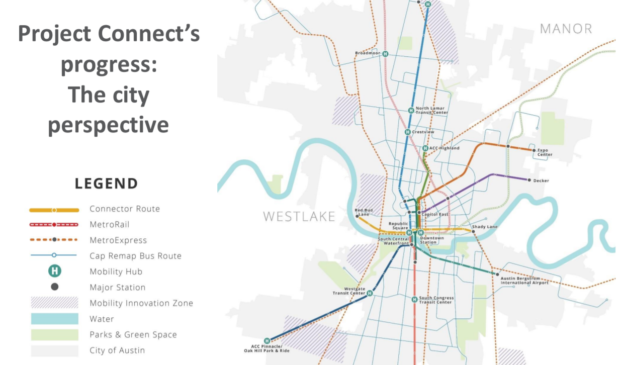Project Connect’s new system map remains mode agnostic
Tuesday, March 27, 2018 by
Caleb Pritchard The Capital Metropolitan Transportation Authority on Monday officially debuted Project Connect’s latest draft system map, a plan that charts a regional network of potential high-capacity transit investments.
A series of multicolored lines trace major corridors, both established and developing, that converge on downtown from a variety of locations on the outskirts of the city.
“This is the first time I have seen anything that I would say is a regional transit plan,” Chair Wade Cooper declared after staff presented the map to the board of directors.
While the map’s unveiling marked a significant milestone in the rebooted Project Connect process, it lacked key details that were included in a preliminary draft version that appeared at a public meeting earlier this year. That document specifically called for three light rail lines and four bus rapid transit routes though it stopped short of matching each to specific corridors, whereas the official draft remains completely silent on exactly what type of transit vehicles could be in store for roads such as East Riverside Drive, South Lamar Boulevard and Guadalupe Street.
However, the corridors are grouped into four categories defined by their expected ridership and costs. For example, the North Lamar Boulevard corridor is ranked as higher ridership and higher cost, while a line connecting the former Highland Mall property to downtown on a route similar to that put before voters in 2014 is expected to yield medium ridership at a relatively medium cost.
“You can read into the tea leaves as you so choose,” Todd Hemingson, vice president of strategic planning and development, coyly told reporters after the briefing. “By looking at the way they’re sorted, you can kind of get a hint of which ones would most likely be rail versus which ones would probably be less likely to have that.”
Hemingson explained that final decisions about potential modes will be pursued during Project Connect’s third and final phase, which will also explore funding scenarios.
Capital Metro’s new President and CEO Randy Clarke explained at the meeting that he personally instructed Hemingson and the planning team to hold off on committing to any specific modes.
“Corridors and dedicated right of way is what matters, and the mode will fit in there,” he explained. “Because it doesn’t matter what mode we go with if we don’t have dedicated right of way on the corridors.”
He also suggested that emerging technologies could add new tools to the transit toolbox.
“We are not that far along from having maybe a (bus rapid transit) type of system that is autonomous, connected and electric that in a lot of ways may meet a lot of the desires and outcomes that modern-day (light rail transit) delivers because you may be able to connect two, three or four vehicles and separate them in a much different way, similar to how light rail system works today but with a lot less cost structure,” Clarke said.
Hemingson told the board that the ultimate cost of bringing the new draft system map to fruition ranges between $6 billion and $8 billion. Development and full construction could take between 20 and 30 years.
For now, the agency will take the draft plan to the public to solicit feedback. On Wednesday, Capital Metro and the Transportation Department will hold their third Traffic Jam event at the new Central Library. The forum will feature the draft map as well as focus on ATD’s ongoing development of the Austin Strategic Mobility Plan.
In June, the agency’s board of directors is scheduled to vote to approve the draft system plan. Project Connect will then enter its third phase as staff begins prioritizing specific projects and establishing a phasing plan. The agency is banking on putting a funding referendum to the voters in the 2020 election.
Before that, however, residents could get a chance to approve a preliminary round of cash for up to $22.5 million worth of engineering and environmental work. The board unanimously passed a resolution asking for City Council to add $15 million to the planned bond election this November to advance that effort. The agency expects to cover the difference with its own funds or perhaps even with the help of Travis County.
This story has been changed since publication to clarify how the draft plan addressed modes, including light rail.
The Austin Monitor’s work is made possible by donations from the community. Though our reporting covers donors from time to time, we are careful to keep business and editorial efforts separate while maintaining transparency. A complete list of donors is available here, and our code of ethics is explained here.
You're a community leader
And we’re honored you look to us for serious, in-depth news. You know a strong community needs local and dedicated watchdog reporting. We’re here for you and that won’t change. Now will you take the powerful next step and support our nonprofit news organization?







